Moderate (D1) to extreme (D3) drought conditions continue to prevail across Puerto Rico and the U.S. Virgin Islands. Some additional deterioration is likely into late April, before the usual onset of the wet season.
View this drought status update in Spanish.
Key Points
- Puerto Rico Conditions: Limited rainfall activity has been observed across the local islands during the past few months. As a result, abnormally dry (D0) conditions to severe (D2) drought conditions continue to prevail across much of Puerto Rico, including Vieques and Culebra.
- U.S. Virgin Islands Conditions: Both St. Croix and St. Thomas are in extreme drought (D3), according to the latest U.S. Drought Monitor. D3 drought conditions are generally expected to occur once every 20 to 50 years. St. John is in severe (D2) drought. These conditions are expected to occur once every 10 to 20 years.
- Puerto Rico Impacts: The fire danger weather in Puerto Rico continues to increase as dryness intensifies. There are reports of soil cracking and dried and brown grass. In addition, several cattle ranchers have reportedly sold a portion, or all, of their cattle due to the high cost of maintaining cattle in drought conditions. A decreasing trend in water levels continued to be observed at reservoirs, rivers, and aquifers across Puerto Rico.
- U.S. Virgin Islands Impacts: Vegetation is showing signs of distress across the territory due to the hot and dry conditions. Intermittent rainfall territory-wide is not recharging ponds and collection containers as any collected water is evaporating quickly due to high temperatures and high winds. Livestock farmers are beginning to purchase hay as vegetation isn’t bouncing back. U.S Geological Survey well data continues to reflect the impacts of long-term drought on groundwater, especially on St. Croix.
- Looking Ahead: Climatologically speaking, the dry season continues into late April, before the onset of the wet season. Therefore, deterioration in drought conditions across Puerto Rico and the U.S. Virgin Islands is the most likely scenario through the end of April before the onset of the May wet season.
- For weather information specific to your area, please monitor products issued by the National Weather Service in San Juan, Puerto Rico.
U.S. Drought Monitor map for Puerto Rico, as of February 1, 2022. The U.S. Drought Monitor is updated each Thursday to show the location and intensity of drought across the country.
U.S. Drought Monitor map for the U.S. Virgin Islands, as of February 1, 2022. The U.S. Drought Monitor is updated each Thursday to show the location and intensity of drought across the country.
U.S. Drought Monitor Categories
U.S. Drought Monitor map for Puerto Rico, as of February 1, 2022. The U.S. Drought Monitor is updated each Thursday to show the location and intensity of drought across the country.
U.S. Drought Monitor map for the U.S. Virgin Islands, as of February 1, 2022. The U.S. Drought Monitor is updated each Thursday to show the location and intensity of drought across the country.
Current Conditions
Drought Conditions
- Puerto Rico: 34% of Puerto Rico is classified by the U.S. Drought Monitor as being in a moderate drought (D1), while nearly 5% of the island is classified as being in a severe drought (D2). An additional 47% is classified as abnormally dry (D0). Vieques is also in moderate drought.
- U.S. Virgin Islands: Drought conditions vary in the U.S. Virgin Islands with severe drought (D2) in St. John, and extreme drought (D3) conditions in St. Thomas and St. Croix.
Rainfall Deficits
- Puerto Rico: The 90-day rainfall deficits now range between 8 and 12 inches across much of Puerto Rico, especially in the municipalities of Rio Grande on the northeast coast, and Arecibo on the northwest coast, except for a few spots in the western interior of the island and west coast near Mayaguez where there is a small rainfall surplus (Figure 1).
- U.S. Virgin Islands: After the passage of Tropical Cyclones Fred and Grace in the first half of August, conditions have been record dry across the Virgin Islands. From August 16 through February 1, Rohlsen Airport at St. Croix has seen only 10.60 inches of rain vs. a 30-year average of 22.23 inches. At Cyril King Airport in St. Thomas, only 11.24 inches of rain was observed vs. a 30-year average of 25.30 inches. These deficits of 12 to 14 inches are the driest such 5.5 month periods at each location in nearly 60 years of climate data—hence, the D3 drought designation by the U.S. Drought Monitor. This is most ominous because the months of September to November are the wettest time of the year. The 5.5-month deficit at St. Thomas is over 2 inches drier than the previous such driest period in 1976/77 (Figure 2).
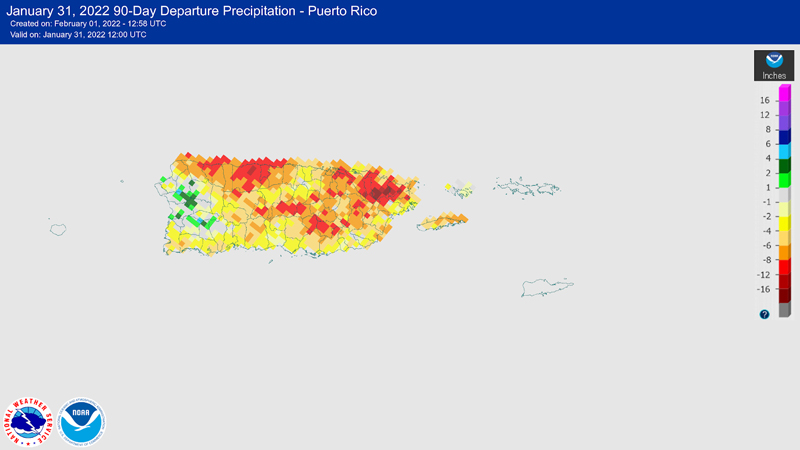
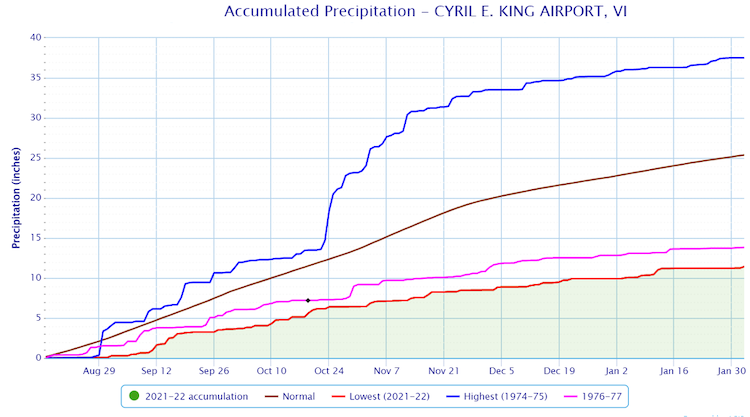
Soil Moisture Conditions in Puerto Rico
Soil moisture data from the Puerto Rico Agricultural Water Management (PRAGWATER) continued to indicate very dry soils across the southern slopes of the island as well as several spots across the eastern interior and northwest Puerto Rico (Figures 3 and 4).
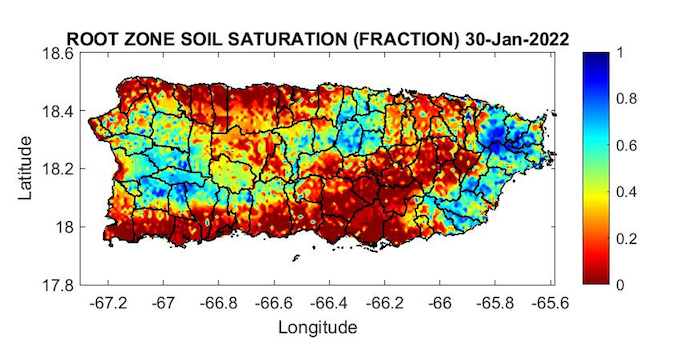
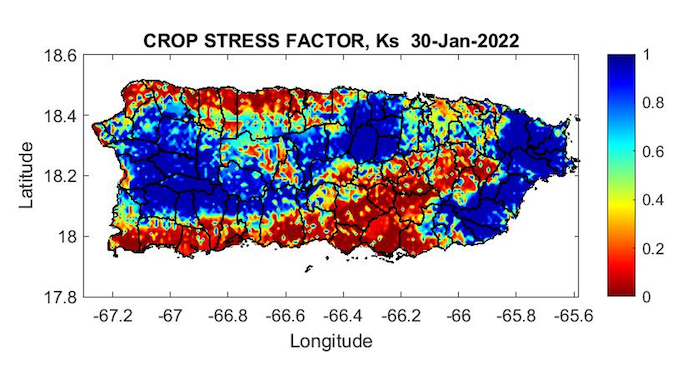
Streamflow Conditions in Puerto Rico
The 28-day average streamflow measured by the U.S. Geological Survey (USGS) river gauge network continued to indicate most of the streamflows across Puerto Rico running well below normal, with many of the sites having levels below the 10th percentile. The Rio de Bayamon near Arenas is currently seeing its lowest streamflow in 23 years of data, with the Rio Espiritu Santo near Rio Grande having its lowest streamflow in 55 years of data. There is no streamflow data for the U.S. Virgin Islands (Figure 5).
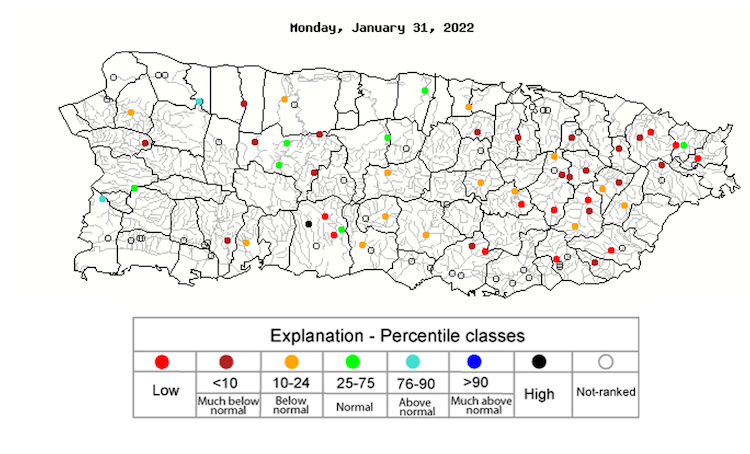
Groundwater Conditions
Groundwater levels retrieved from the U.S. Geological Survey network continued to indicate a decreasing trend across most of the representative wells (Figure 6). Several wells across southern Puerto Rico are in critical conditions with values much below the normal range.
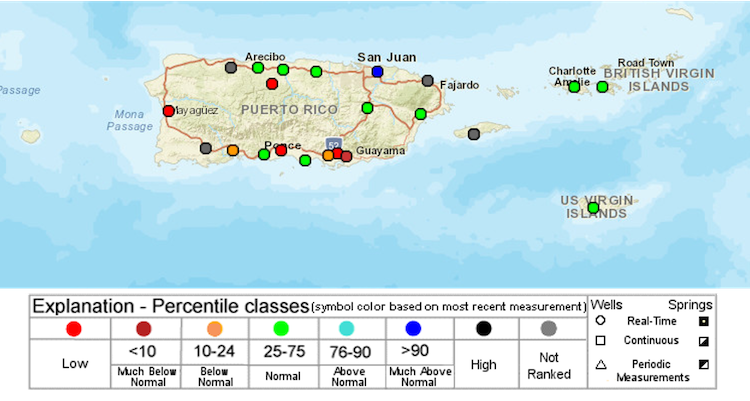
Outlooks and Impacts
Rainfall Outlook
Based on the 3-month extended forecast by the Caribbean Climate Outlook Forum (CariCOF), there is no predictability across the area (Figure 7), with equal chances of above-, below-, or near-normal rainfall. However, climatologically speaking the dry season continues into late April, before the onset of the wet season. Therefore, the deterioration of drought conditions across Puerto Rico and the U.S. Virgin Islands is the most likely scenario.
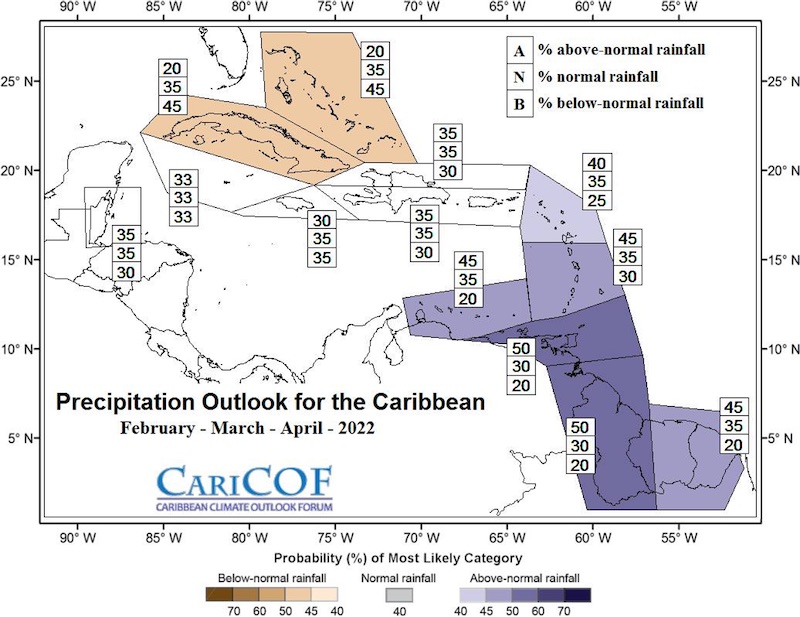
Sector Impacts
General Conditions
- Puerto Rico: Reports indicate that infrequent and/or light rains have not been enough to alleviate dry pastures and soils, specifically in the southern region (report received from municipalities Lajas, Guánica, Juana Diaz, Santa Isabel, Cabo Rojo, Hormigueros, and Hatillo). In the south, heat and wind have likely reduced the alleviating effect of light rains.
- U.S. Virgin Islands: January is normally the driest time of the year, and all major islands in the USVI are drier than normal. Currently, St. Croix remains at D3 (SL)—Extreme Drought with indicators of both short and long-term impacts—while St. Thomas is now also at D3 (SL). St. John is currently at D2 (SL). Normal expectations of precipitation levels are not being seen during this time, and this is concerning to many farmers as they store much of the water for the year during this period. Groundwater tables also show a decrease in water availability.
Agricultural Conditions
Puerto Rico:
- Pasture: Drought conditions have led to poor pasture conditions in some areas. There are reports of dry and brown pasture, soil cracking, and drying of a water pond from various municipalities in the south and north (Lajas, Guánica, Juana Diaz, Santa Isabel, Cabo Rojo, Hormigueros, and Hatillo). These conditions are atypical of this period in the post-winter rainy season.
- Livestock: Due to a limited supply, or lack of, green pasture, cattle ranchers in several municipalities are providing livestock with hay, liquid supplements, and feed. Sustained reliance on these supplemental options can be cost-prohibitive for some ranchers. Due to the high cost of maintaining cattle in drought conditions, several cattle ranchers have reportedly sold a portion, or all, of their cattle and/or calves. As dry conditions continue, they are finding it increasingly difficult to maintain their operations. Some ranchers expect to sell more livestock to reduce operation cost.
- Crops: Low soil moisture and low rainfall have led agricultural professionals to adjust their management practices as they aim to retain soil moisture in drought conditions. On a farm in Santa Isabel, more irrigation hours are being applied, as rainfall has reportedly not exceeded evapotranspiration for the last two months. On a farm in Aibonito, mulch has been laid to retain soil moisture.
St. Thomas:
- Poultry farmers indicated that due to a lack of rain, they are beginning to purchase water, as their water source for chickens (cisterns filled by harvesting water) is depleting. They also stated that increased heat is impacting egg production. Farmers are also reporting hot, dry, and windy weather conditions that contribute to a lack of soil moisture. The agriculture pond as well as the private pond above have not filled completely due to a lack of rain. Specialty and row crop farmers are reporting that greens, including lemongrass, kale, and peppers, are burning due to heat. Orchards, which require more water, are also only being watered every other day. Most farmers though are employing conservation methods, including increasing the use of drip irrigation methods, and are also working to increase the storage capacity of water.
St. John:
- Farmers are reporting that they are watering both early and late to conserve water. Many are using mulch to help retain water in the soil. Farmers are implementing immediate conservation methods, including crop rotation and alternating watering schedules to maximize water resources. Farmers also indicated that the need for increased irrigation and Smart Technology will help them to combat drought and potentially to increase production.
St. Croix:
- Farmers are purchasing water and, as a consequence of this additional expense, they are decreasing production. Farmers of all sizes are also reporting that hot, dry weather is still affecting their ability to retain soil moisture and collect water. One large producer reported purchasing 12,000 gallons of water per week, which will become cost-prohibitive if drought conditions continue. Long-term drought indicators are creating an underlying need for additional irrigation systems in the fields. Poultry farmers are reporting increased purchases for water in cisterns and decreased egg production due to heat. The VI Department of Agriculture (VIDA) also reported that, on St. Croix, water deliveries to the agricultural community in mid-December were listed as 680,978 gallons. VIDA also reported that in January the number of gallons delivered was more than 770,850. Since drought conditions continue overall, livestock farmers are planning mitigation efforts to continue to rotate livestock to feed them.
For More Information
- National Weather Service (NWS) Weather Forecast Office – San Juan: Climate and Drought Information
- NWS Drought Information Statements for Puerto Rico and the U.S. Caribbean
- Drought.gov:
- Caribbean Drought Bulletins. Caribbean Regional Climate Center, Caribbean Institute for Meteorology and Hydrology (CIMH), Barbados
- U.S. Department of Agriculture (USDA) Caribbean Climate Hub drought and disaster assistance resources for tropical forestry and agriculture
Prepared By
Odalys Martinez
NWS Weather Forecast Office – San Juan
Meredith Muth
NOAA/National Integrated Drought Information System (NIDIS)
William Gould, Nora Álvarez-Berríos, Eva Holupchinski, and Luis Alexis Rodriguez Cruz
USDA Caribbean Climate Hub, USFS International Institute of Tropical Forestry
Christina Chanes, Gregory Guannel
University of the Virgin Islands
Victor Murphy
National Weather Service Southern Region
Brad Rippey
USDA Office of the Chief Economist
Héctor J. Jiménez
Office of Climatology, University of Puerto Rico
Puerto Rico Reporting Input: Thanks to the Agricultural Extension Service, College of Agricultural Sciences, University of Puerto Rico-Mayaguez (UPR-M). Special thanks to Eric Harmsen, Professor of Agricultural Engineering UPR-M; Prof. José L Zamora, Agricultural Extension Service, UPR-M; Prof. Jeannette Rosado-Martinez, Agricultural Extension Agent; Samuel Prieto, Agricultural Extension Agent; Betzaida Ortiz Carrion, Vice President of Finca Atabey farm; M. Carlo; N. Cruz; and U. Cruz.
USVI Reporting Input: Several individuals contributed to this report, and we acknowledge the following for their support, including the faculty, staff, and collaborators of the UVI Physics Program, UVI Etelman Observatory, UVI Agricultural Experiment Station, VI Department of Agriculture, and UVI Caribbean Green Technology Center, as well as the USDA Office of the Chief Economist, National Parks Service in St. Croix, USDA Farm Service Agency, Coral Bay Community Council, and the many field staff, volunteers, drought reporters, and farmers from across the territory.
About This Report
This drought update is issued in partnership between the National Integrated Drought Information System (NIDIS), National Oceanic and Atmospheric Administration (NOAA) National Weather Service, the U.S. Department of Agriculture (USDA), and the University of the Virgin Islands. The purpose of the update is to communicate a potential area of concern for drought expansion and/or development within Puerto Rico and the U.S. Virgin Islands based on recent conditions and the upcoming three-month forecast.
NIDIS and its partners will issue these updates every two months. Subscribe for these U.S. Caribbean drought updates here.





